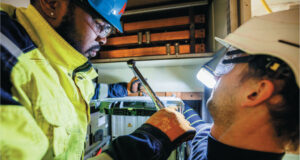In my article for Paper360°’s September/October issue, I wrote about working in a reactive maintenance organization at a chemical company years ago. The first step was to identify equipment problems and repair them.
This article dives into creating a maintenance management process. How do you move from being a reactive to a proactive organization in maintenance and reliability?
SMART SOLUTIONS
After working as a maintenance engineer at the chemical company for a few days, I realized that we lacked the right tools, a work management process, leadership direction, and accountability. We did, however, have a highly vocal maintenance team. They shared their dissatisfaction in a nonproductive way, causing the stakeholder to lose confidence and developing a bad reputation for the plant. Operating performance was very low compared to our counterparts in Europe, South America, and Asia. A major part of the low performance was due to the equipment.
As a maintenance person I always believed that maintenance excellence is not about just changing broken components when you make a repair. Maintenance excellence is about coming up with smart solutions for repairs or modifying equipment and processes. My motto was “Competitive advantage is not value added unless it is done with limited resources.” This was something that my grandfather instilled in me. “With few resources, you can make anything work at any time,” he would say to me. He was a very confident man.
SO WHERE DO WE START?
The first step was to identify equipment problems and then repair. We started by updating prevention and condition monitoring tasks in our CMMS. The number of work requests was growing quickly, which was a great sign that our PM strategy was working. But we did have a few hiccups along the way.
We implemented a full-fledged vibration analysis program. As time went on, we started to identify different problems on our rotating equipment. Our data showed that we predicted around 90 percent of all the rotating bearing problems before they caused downtime. We found failed (still running) bearings on large compressor motors, pumps, gearboxes, and agitators. We felt that this was a major step in improving our condition monitoring program. We normally saved the bearings or damaged parts that we found to make sure that we could physically see the failure and use it for training.
One day the senior machinist, Curtis, and the lead mechanic, Fred, wanted to talk to me. They had one of the big bearings from the main process air compressor on the table in the satellite shop. “Look at this bearing,” said Fred. “There is nothing wrong with it!” I looked at the bearing. I agreed no damage was visible on the bearing surface by just looking at it. I said, “Our analyses are only right nine out of 10 times so you could be onto something, Fred.”
Earlier that month, we had requested to change a bearing in a high-pressure pump (read the details in the previous article). Our analysis that the high pressure in the pump’s spikes was due to wear or damage on the bearing surface was incorrect. That mistake seemed to stay in the mechanics’ minds.
But because this was a high speed 3600 RPM motor, it was possible that there was damage not visible by simply looking. When we used a magnifier to evaluate the bearing surfaces, the outer race showed cracks and some spalling already underway. Fred and Curtis nodded after they saw the damage. Getting buy-in for the condition monitoring program is a big win toward becoming a proactive culture.
DON’T REINVENT THE WHEEL
We realized that many of our sister plants were doing a much better job maintaining rectors, large compressors, filtration units, material handling equipment-basically all processes and utility equipment-compared to us. Based on that I asked my boss to take a trip to the other plants in Europe to learn what they are doing. My boss was not exactly thrilled by my request at first.
Moving ahead anyway, I wrote a report comparing the equipment throughput for our site with help from the operations managers. We estimated that we could increase our site output 10-20 percent if we could match or beat their performance. After I presented this to the operations management team, my trip was approved. I carefully planned the trip with my counterparts at the other sites.
When I arrived, we reviewed maintenance procedures, talked to craftspeople, climbed over equipment, and crawled into tanks, taking pictures and notes. When I returned home, I sat down with the maintenance staff to share information. From a technical standpoint, this trip showed us the most important things to do to improve. We learned how to align large equipment; dynamically balance large agitators; prevent contamination; improve maintenance of our control systems, electrical systems, and substations; and significantly improve the life of pumps and rotating equipment in general.
OPERATIONS ASKS, ‘WHAT ARE YOU TRYING TO DO?’
A few months later, the maintenance supervisor stepped into a different role. Our talent department brought in several candidates for interviews. I was not interested in applying for the position since I was still busy working on the improvements we found. One day as I was walking into the central maintenance shop, the maintenance department cornered me. I got a little worried and asked them what was going on. Fred said to me, “You need to apply for the maintenance supervisor position!” It was very quiet in the shop for a long time, and then I said okay.
I applied and got the job. It took a few weeks, but I was finally brought into the operations management meeting. Right off the bat they asked, “So, what are you trying to do with the maintenance department?” I replied that we needed some time to develop a plan. “Okay,” said the VP of technical operations, “you have two weeks!”
I sat down with our maintenance staff—a really smart bunch of people. We came up with a simple but great plan with the following highlights:
- We will beat the performance of our sister plants-just some friendly competition to improve performance. This showed our ambition level to our stakeholders.
- We will train the operators to inspect the equipment condition and write work requests.
- We will have the maintenance schedule completed on Thursday with planned work orders for the following week.
- We will need to partner with operations. They are not allowed to bypass planning and scheduling.
- Maintenance will need a person to coordinate activities with operations.
- We will assign maintenance leads in each operating unit to coordinate and be responsible for the quality of maintenance work.
We presented this to the operations management team and got a thumbs up. I don’t think they believed that it would happen, based on our history. Nevertheless, the operations and maintenance coordinator, along with the team leads, helped push our performance to a new level in just a few months.
CREATING THE GAME PLAN
Let’s talk football for a minute. You must learn to block and tackle before implementing a complicated game plan. We started to get good at blocking and tackling, so now it was time to develop our game plan (and make Vince Lombardi proud).
Step 1: Our Mission
Our plant was improving in terms of both performance and investments. Expansion was the reward for our improvements, and expansion was rapid. At this time, I was promoted to maintenance manager. In my new role, I felt that it was time to improve our interfaces with other functions, so we came up with the idea to develop a mission statement (see sidebar).
Step 2: Organizational Structure and Resources
The different operating units and facilities frequently gave us advice or complained that we should have more resources in their area. Based on that, we felt that we needed to show them how we organized our maintenance department. The objective of our organizational structure was to provide:
- Decentralized partnership
- Centralized flexibility to move resources
- Centralized support for planning and scheduling, purchasing, storeroom, engineering, and predictive maintenance.
The idea behind the structure was to have a core group of maintenance (decentralized) in each area to be familiar with the equipment and provide excellent communication with our partner in operations. We would also have centralized and specialized knowledge in a central group that would be responsible for the site utility system and operation. Additionally, the central group would have resources to support decentralized organization when the workload was high.
We needed a way to show the stakeholders that all work was prioritized and scheduled based on business requirements. We developed backlog limits for each area based on the resources in the unit (decentralized). Then, backlog limits were based on agreement with quality management organization to make sure we were in compliance with GMP requirements for some of our food grade products, but also to make sure that we could repair equipment in a timely manner.
We shared our backlog limits for each function in the monthly meeting with our stakeholder to review performance. The backlog showed that none of the functions had a high backlog and that all work was prioritized based on a formal priority system. Backlogs were managed based on employee hours:
- Upper limit was 4 weeks
- Target limit was 2 weeks
- Lower limit was 1 week
The truth of something must be judged by the business results, not emotional priorities.
Step 3: The Flywheel Effect
We improved in all areas of the basic maintenance processes, confidence grew, and we knew we were doing great!
I think the single most important thing that stands out: We had a great bunch of people. They were motivated, knowledgeable, and showed leadership to make things better every day. They had the “winners’ mentality.”
One way I gauged this: tradespeople and staff came to my office every day with ideas about how to improve. This is the “flywheel effect.” Improvements were moving forward on their own. We felt that we were ahead of the game, driving improvements in operations and engineering instead of the other way around.
The journey of this chemical plant from reactive to proactive maintenance underlines the impact of implementing efficient systems and seizing strategic opportunities. The process involved getting buy-in, improving condition monitoring techniques, and teamwork between departments. As the maintenance team’s competence and determination grew, they not only met but exceeded their objectives, leading to success, expansion, and living up to the mission statement. Proactive maintenance can make a big difference when guided by effective leadership and a drive to get better.
Email me at [email protected] for a checklist of maintenance improvements we completed—you may want to consider or explore further what can benefit your maintenance organization and operation. I will also include a list of improvement results over the 4-year period at the chemical company.
 Paper 360
Paper 360

